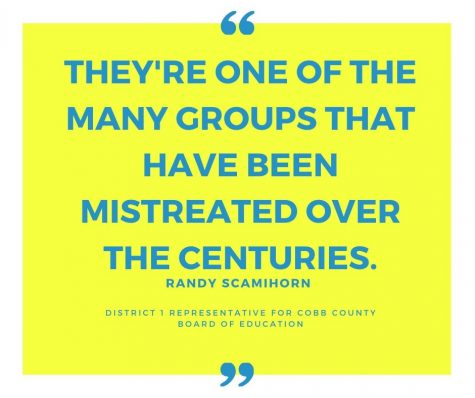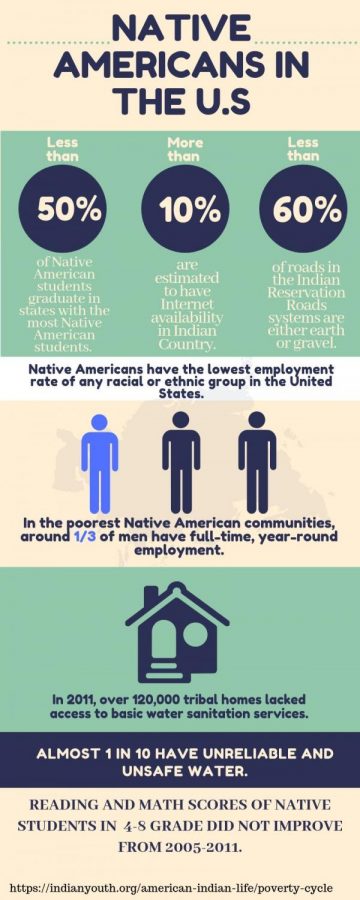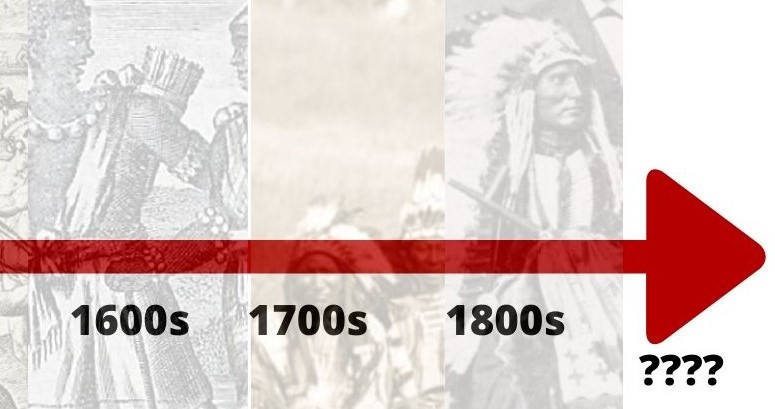Your donation will support the student journalists of North Cobb High School. Your contribution will allow us to purchase equipment and cover our annual website hosting costs.
America’s whitewashed version of Native American history
December 2, 2019
The American school system teaches children about the history of the country from a young age. Children learn about Christopher Columbus “sailing the ocean blue” in search of new land. Upon arriving, history teaches that Columbus heroically discovered America and the “savages” that inhabited the land. However, the public education system fails to address the lives and cultures of those people before Columbus’ discovery, and how their lives continue afterward.
“Both in terms of statistics and in terms of human welfare, it is a fact that America’s first citizens, our Indian people, suffer more from poverty than any other group in America. That is a shameful fact,’” President Lyndon B. Johnson said.
Since the introduction of President Lyndon B. Johnson’s plan and “War on Poverty” in 1964, progression in overall resources for Native Americans failed to improve. Johnson enrolled thousands of Native Americans into school programs in a futile attempt to keep them on the same education level as other Americans.
While Native Americans live in the United States, they still lack the same resources and opportunities given to the rest of the country. Studies reveal that Native Americans lag behind other Americans in the education system with only 16% of Native Americans graduating, compared to their white counterparts with a 42% graduation rate.
The oppression of Native Americans remains a constant reminder that they still lack the necessary resources for a successful life. Throughout American history, the mention of Native Americans remained limited, and when discussed, their history and subsequent disappearance made key points. Their presence in America signifies a resilience to stand their ground and to an extent, preserve their culture.
The Georgia education curriculum includes discussion of Native Americans prior to the 18th century, but everything after that seems to disappear, almost as if their people and cultures cease to exist.
“In general, I do not think that Native Americans are well represented in our educational system at all. I think our educational system, in general, tends to focus on just the first Thanksgiving and the Trail of Tears and the things that historically seem like you have to address, but they’re able to gloss over the significant issues that they are still facing today,” Magnet American literature teacher Alex Yeganegi said.
The lack of knowledge of Native Americans highlights the failure of the American public education system to fulfill their purpose in educating students. As a significant part of American history, Native Americans suffer insufficient representation of their cultures without an overlying European influence.
“In multicultural literature, we do an entire unit about Native Americans and how they have actually been excluded from America instead of united. We do a lot of research about cultural appropriation and how Native American culture has actually been “killed” by the white people on their reservations and within that, they also research various issues that native Americans are facing today. In magnet American lit, we do a unit about how native American culture is one of the hidden issues in America that is also not discussed and we synthesize a bunch of informational texts and other resources that similarly discuss current issues among the native Americans,” Yeganegi said.
In schools, students typically learn of Native Americans in the first few units of their classes, and as a result, students develop an idea of Native Americans only existing in the early 1800s.
“Leaving their reservations off of Google maps, and failing to include them in our media. It might also explain why we expect Indian-themed art to always feature a pre-modern world. Curricular choices matter. So long as young people learn to think of Indians no differently than they do Vikings and Ancient Romans, they will overwhelmingly fail to notice or care about ongoing interpersonal and institutional discrimination against American Indians who are here now,” Pacific Standard contributor Lisa Wade said.
Currently, Native Americans make up approximately 2.09% of the current United States population. However, history points to Native Americans as humans of the past. Lack of detailed discussion on current Native American conditions leaves Native Americans in the same situations and prevents them from evolving with the rest of American society.

Outdated school textbooks and curricula fail to include modern-day issues of Native Americans. Over the years, they faced their achievements and disappointments, going unnoticed to the outside world. Their impact on American life goes silent throughout history, along with the modern-day issues they continue to face. They remain–a forgotten America.
“A recent survey found 40 percent of respondents didn’t think Native Americans still exist,” Great Falls Tribune contributor Kristen Inbody said.
Native American issues continue to present themselves both in schools and the outside world as school sports teams misrepresent Native Americans through their mascots. As of 2013, approximately 2,129 national sports teams held references to Native Americans, with the most popular name–the Warriors.
“Our mascot undermines any education that is about the struggle of indigenous and native Americans who were wiped out by white greed and racism. Moreover, our mascot is co-opted and racist. This makes any education from our school less valuable because our school is continuing the legacy of racist oppression and humiliation. By making minority groups into caricatures, we invalidate their identities and make their voices less accepted by those in power,” Magnet senior Chandler Quaile said.
As governments subjected them to living on reservations to preserve culture and traditions, Native Americans consequently receive lower grades and undergo lower graduation rates. Even beyond the reservations, Native American students continue to fall behind their American counterparts.

As schools leave students unaware of the extent of issues lying in Native American communities, students should take it upon themselves to further their education and do self-research. Books and other texts provide an extra perspective into the lives of Native Americans, helping readers to further understand the issues they face within their communities. Engaging classrooms and students with firsthand experiences can aid in solving future situations.
“Last school year 67 percent of American Indian students graduated from high school compared [to] the national average of 80 percent,” Senior Education writer for US News Lauren Camera said.
Outside of education, the absence of economic resources on reservations results in high unemployment rates, families living below the poverty line with low-income, and sanitation issues.
The American education system teaches students about Native American history, referencing the relations within and between tribes. However, schools frequently describe tribes as synonymous with each other when in reality, they follow different ideals and traditions.
“Unfortunately, this inaccuracy is mild compared to some of the other things I discovered while reviewing how Native Americans are portrayed in the history textbooks used in our schools, and how they have been regarded by society. It’s no wonder that some of the general public, and to some extent, even a former president of the United States, continue to think of Native Americans as ‘savages,’” prominent Alaska Native political leader Georgianna Lincoln said.
Without American students gaining sufficient knowledge of current Native American issues in the United States, policies on their rights become more difficult to change.
“‘The complete lack of representation in the media, in pop culture, in K-12 education not only erases us from the American consciousness, it inadvertently creates a bias,’ explained Echo Hawk. ‘People were less likely to support certain rights and social justice issues for Native people when they had zero perception and understanding of who we are. Invisibility and erasure is the modern form of racism against Native people,’” Women’s Media Center contributor Rebecca Nagle said.
The importance of learning Native American history presents itself in our lives as the prevalence of social media allows Native American issues to reach a larger audience and garner attention, hopefully sparking change.
“American students should be required to learn the struggles of [people of color] throughout America’s history in the gov[ernment] and U.S history. This needs to be holistic and honest, owning the legacy of our ancestors. We cannot move forward until we have made reparations and learned the struggle of those whose futures we have been complicit in robbing. There is no excuse for ignorance and complicity. Those who have the privilege of education and privilege in society have the obligation to understand who’s backs it was built on,” Quaile said.
Students educating themselves on Native American problems still prove vital as the education system still faces a long journey ahead. In taking the steps to gain and further first-hand knowledge, students prepare themselves for their future with solving these issues.

James E Clipper • Nov 26, 2020 at 3:45 PM
It is indeed a egregious indictment against the American government regarding the morbid social status of erroneously so-called native Americans who actually migrated from Siberia’s Altai Mts. The USA broke nearly every treaty they made consequently resulting in today’s native Americans resting at the bottom of the proverbial totem pole. Nonetheless history is written by the Victor which excludes the true swarthy Indigenous Aboriginal Hebrew Moors who discovered Amoorika ie “They Came Before Columbus.”
http://www.moorsinamerica.com